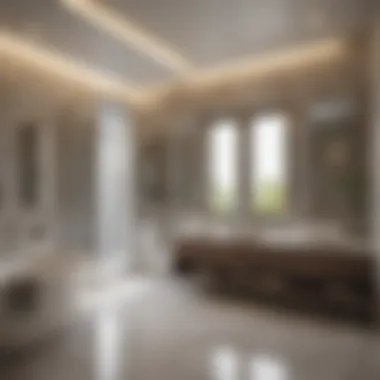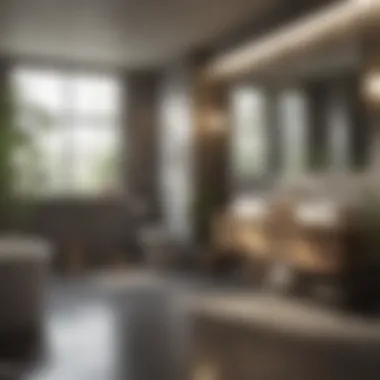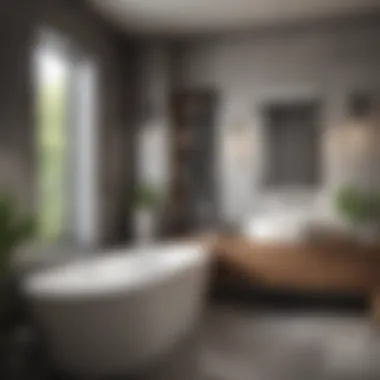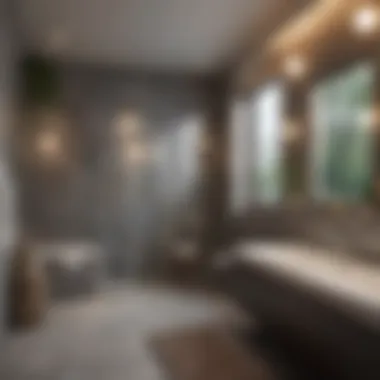Understanding the Average Cost of a Master Bathroom Addition


Intro
Adding a master bathroom is a significant investment for homeowners. It offers not only added convenience but can also enhance property value. Understanding the financial implications requires a thorough exploration of various cost components. This article aims to break down the average cost involved in this project, focusing on essential factors like materials, labor, and design influences. By examining regional price variances, this analysis will provide a clearer picture for potential renovation seekers. The insights gathered here are meant to assist homeowners in making informed decisions when considering this type of upgrade.
Design Inspiration
Designing a master bathroom involves more than just layout; it includes thoughtful consideration of both current trends and personal tastes. An aesthetically pleasing bathroom can offer a serene escape, making it imperative to align your renovation decisions with contemporary design principles.
Current Trends in Interior Design
Bathroom design trends often reflect broader interior design movements. There is a noticeable shift towards sustainable materials, which can reduce long-term costs and environmental impact. Popular choices now include:
- Natural Stone: Marble and granite offer durability and elegance.
- Eco-friendly Fixtures: Water-saving toilets and energy-efficient lighting are increasingly in demand.
- Open Spaces: Many homeowners are opting for layouts that emphasize spaciousness, including walk-in showers and freestanding tubs.
Color Schemes and Palette Ideas
Choosing the right color palette is essential for achieving the desired atmosphere. Soft, neutral tones are frequently chosen for their versatility and calming effect. However, bold colors can be used strategically to create focal points or add personality. Some effective choices include:
- Soft Greys and Whites: Clean and classic, this palette can make small spaces appear larger.
- Earthy Tones: Greens and browns evoke a sense of nature and tranquility.
- Accent Colors: Teal or navy can provide depth without overwhelming the visuals.
"A well-designed master bathroom not only serves functionality but also acts as a sanctuary for relaxation."
Understanding Costs: An Overview
In the next section, we will explore detailed elements contributing to the average cost of adding a master bathroom. This will provide a foundation for comprehension of financial aspects involved.
Preamble to Master Bathroom Additions
Adding a master bathroom is a significant undertaking for any homeowner. It is not merely a matter of aesthetics; it also enhances functionality and comfort. A master bathroom can transform the daily routine into something more enjoyable. This section explores what defines a master bathroom, along with its growing popularity.
Definition of a Master Bathroom
A master bathroom typically refers to a private bathroom attached to the master bedroom. It is designed for convenience, often featuring amenities like a shower, bathtub, double vanity, and sometimes a separate toilet area. In many homes, it serves as an oasis of comfort, reflecting personal style through design choices. The sophistication of a master bathroom lies in its ability to combine luxury, practicality, and a personal touch, making it distinct from other bathrooms.
Growth in Popularity of Master Bathrooms
Over the last couple of decades, the master bathroom has seen a surge in demand among homeowners. Several factors have contributed to this trend:
- Changing Lifestyles: Many people now prioritize personal space and comfort. A well-designed master bathroom offers a retreat from the rush of daily activities.
- Real Estate Value: A master bathroom addition can significantly increase a home's market value. Surveys have shown that homes with well-appointed master bathrooms tend to sell faster, appealing to prospective buyers.
- Aesthetic Appeal: The rise of interior design as a focal point in home improvement adds allure to master bathrooms. Homeowners can customize these spaces, integrating modern design trends and materials that match their taste.
- Functionality: Often, families require more than one bathroom, especially as household sizes grow. A master bathroom provides efficiency and convenience for the designated primary bedroom occupants.
This demand for master bathrooms aligns with the broader trend of investing in home improvement projects that enhance the quality of living while also promising better return on investment in real estate.
Factors Influencing Cost
Understanding the factors that influence the cost of adding a master bathroom is crucial for homeowners considering such an investment. Each element plays a significant role in shaping the financial landscape of this project. From layout choices to the quality of materials used, these factors will ultimately determine both the budget and the value derived from the addition. Evaluating these components helps in making well-informed decisions that align with personal preferences and long-term goals.
Size and Layout Considerations
The size and layout of the new master bathroom are significant determinants of the overall cost. Larger spaces typically require more material and labor. High ceiling heights, complex layouts, or custom designs may also add to expenses. For instance, if the layout encompasses additional plumbing, such as multiple sinks or a standalone bathtub, the costs escalate further. The bathroom's shape can complicate construction too—irregular spaces might need more intricate design solutions.
When planning the size, consider the existing home infrastructure and how the new bathroom will integrate into that. Recognizing the limitations and possibilities of the current space helps to avoid unexpected costs down the road.
Choice of Materials and Fixtures
Quality and type of materials chosen for the bathroom directly impact the cost. High-end fixtures, such as luxury faucets or designer tiles, can quickly elevate expenses. On the other hand, opting for standard fixtures and more economical tiles can help manage costs without sacrificing too much on aesthetics.
Every material choice affects performance, durability, and maintenance. Homeowners should weigh the long-term benefits of premium materials against their upfront costs. Investing in well-made fixtures may provide savings in the future through fewer repairs and replacements. Moreover, energy-efficient options, although often more expensive initially, can lead to utility savings over time.
Labor Costs and Contractor Selection
Labor costs form a substantial part of the budget when adding a master bathroom. Skilled labor tends to demand higher wages, reflecting the quality of work expected in such a project. Hiring licensed contractors, who may charge more, ensures compliance with safety regulations and local building codes.


Choosing the right contractor requires careful consideration. It's essential to compare estimates and check references. Engaging a reputable professional can minimize the risk of costly mistakes during the renovation. Also, be clear about expectations and timelines to ensure smooth communication throughout the project.
Permitting and Regulatory Fees
Permitting is often an overlooked element that can add unforeseen costs to bathroom renovations. Depending on local regulations, obtaining the necessary permits for plumbing and electrical installations may be compulsory. Failing to secure these permissions can lead to fines and project delays.
Homeowners should research the specific requirements in their area. Some municipalities impose substantial fees for permits, while others might have streamlined processes. Engaging with local authorities prior to project commencement arms homeowners with vital information and helps budget appropriately for these costs.
Average Cost Breakdown
Understanding the average cost breakdown is crucial for homeowners who are considering adding a master bathroom. This section delves into several key elements that contribute to the overall financial implications, helping to guide informed decision-making throughout the renovation process. Analyzing costs helps to set realistic budgets, prioritize essential features, and fully appreciate the impact of design and function in both day-to-day living and long-term property value.
Estimated Overall Costs
National Averages
The national averages for adding a master bathroom provide a reference point for many homeowners. On average, the cost ranges between $15,000 to $40,000, depending on various factors. One significant aspect of national averages is that they consolidate data across many regions and projects, giving a broader picture than local estimates might present. This general view offers useful insight, especially for those just beginning their planning.
A key characteristic of national averages is that they can highlight common trends in pricing and labor. Knowing this can lead homeowners to make educated choices about their budgets. However, relying solely on national averages disregards the variations that exist in specific locations.
"You can use national averages as a starting point but always consult local professionals for exact quotes."
Regional Variances
Regional variances play a significant role in the cost of adding a master bathroom and can greatly influence overall expenses. For example, urban areas tend to have higher labor and material costs compared to rural locations. This can result in price differences of up to 30% or more when comparing locations like New York City to a smaller town in the Midwest. These variations are fueled by local economies, demand for contractors, and availability of materials.
The uniqueness of regional variances offers a valuable perspective. By understanding local cost factors, homeowners can tailor their budgets realistically. While higher costs may seem daunting, it could be necessary to ensure quality work and materials. Understanding this can mitigate unexpected financial strain once renovations begin.
Itemized Cost Analysis
Plumbing and Electrical Work
Plumbing and electrical work is an essential aspect of adding a master bathroom. These costs can vary greatly based on the complexity of the installation. For instance, relocating existing plumbing fixtures will typically increase the cost significantly, while straightforward replacements may require less expense. Additionally, ensuring that the electrical systems can handle additional load will incur extra costs.
The criticality of plumbing and electrical work is obvious, as improper installations can lead to larger issues down the line, such as leaks or safety problems. Homeowners must invest adequately in skilled tradespeople to handle these facets, making this a beneficial focus in the overall budget. Although it may seem like a large block of spending, it often pays off significantly in longevity and safety.
Cabinetry and Countertops
Cabinetry and countertops represent another major investment in a master bathroom. The cost of custom versus pre-made options can diverge widely, affecting the overall budget. Custom cabinetry can add elegance and personalization, yet it comes at a higher price compared to standard models.
An attractive feature of investing in quality cabinetry is the long-term benefit it brings. High-quality cabinets will not only withstand daily use but also add aesthetic appeal that can enhance the bathroom's value. This investment can yield higher satisfaction and can resonate well during resale, making it a popular choice among homeowners.
Flooring and Tiling
Flooring and tiling costs can vary based on material choice and installation complexity. Options such as porcelain tile, luxury vinyl, or natural stone each come with different price tags. Installation can also be a significant factor, as DIY methods may save money but could compromise quality unless done correctly.
An important point about flooring and tiling is their impact on bathroom ergonomics. Choosing the right finish can enhance not only the visual appeal but also the functionality of the space. Flooring must be durable and easy to clean, so investing in quality materials often proves advantageous in the long run. Even though it represents a significant portion of the budget, proper flooring often yields higher satisfaction and longevity.
Through these detailed analyses, homeowners can better prepare for the costs associated with adding a master bathroom. Each area discussed provides significant insight into the total expenditures involved. By breaking down the costs, homeowners can distinguish between necessary expenses and optional upgrades.
Design Considerations
The design of a master bathroom is critical. This section will delve into various design considerations that can influence the overall feel and functionality of the space. Beyond aesthetics, a well-thought-out design can enhance daily routines and improve the usability of the space for years to come. The choices made here can also directly impact costs and return on investment.
Choosing a Functional Layout
The layout of a master bathroom should prioritize functionality. Common layouts include L-shaped, U-shaped, and galley styles. Each provides different advantages based on the size and shape of the space available. For instance, a U-shaped layout maximizes storage and can accommodate separate areas for the shower and tub. When choosing a layout, consider how the space will be used daily. Will it serve multiple people at once? Is a dual-sink vanity preferred? These considerations will help create a functional environment.
Incorporating Modern Design Trends
Modern design trends can significantly impact the look and feel of a master bathroom. Popular elements such as minimalism, open-concept layouts, and natural materials are often favored. Utilizing large-format tiles can create an illusion of more space. Additionally, investing in high-quality fixtures, such as wall-mounted faucets or smart shower systems, elevates the bathroom's appeal. Exposure to trends also allows homeowners to express their personal style while potentially increasing the home's value.


Sustainability in Bathroom Design
Sustainable design is becoming increasingly relevant. It addresses environmental concerns while promoting resource efficiency. Key elements include low-flow faucets, dual-flush toilets, and energy-efficient lighting. Incorporating sustainable materials like bamboo or recycled glass can further enhance the ecological impact. In addition to benefiting the environment, sustainable practices can lower utility bills and improve the home's overall appeal to environmentally-conscious buyers.
"A well-designed bathroom that incorporates sustainability can lead to long-term savings on utility costs and make a home more attractive to future buyers."
In summary, the design considerations of a master bathroom go beyond mere aesthetics. Every aspect, from layout and trends to sustainability, plays a vital role in crafting a functional and appealing space.
Return on Investment
Return on investment (ROI) is a crucial concept when considering a master bathroom addition. Homeowners should understand its implications and how it plays a significant role in evaluating the overall value of their investment. An increase in property value is often the primary aim of such renovations. However, the effectiveness of a master bathroom addition in achieving this objective depends on various factors.
When assessing ROI, it is essential to calculate not only the initial investment but also the potential value added to the home. Multiple elements come into play, including the quality of materials used, pricing of local labor, and current real estate trends. Homeowners must carefully evaluate these factors to make informed decisions that align with their financial goals.
"Investing in your home should create value and comfort, a master bathroom can serve as both."
Assessing Potential Value Increase
To assess the potential value increase from adding a master bathroom, one must look at both local housing markets and general trends in home valuations. Typically, homeowners can expect a return averaging between 50% and 70% of the total cost of the project. However, several specifics can alter this estimate significantly.
- Location: Homes in areas with higher property values may see a greater percentage return.
- Market Demand: If master bathrooms become highly sought after in your area, that can lead to an increased return.
- Overall Home Condition: A home that is updated and well-maintained often sees a higher return when adding a master bathroom.
Understanding these variables will allow homeowners to make informed decisions when budgeting for this type of renovation.
Market Trends and Resale Value
Staying aware of market trends is essential for homeowners considering a master bathroom addition. A well-structured remodel can enhance resale value when done correctly. Recent trends have shown that buyers are willing to pay a premium for homes with additional bathrooms, particularly master suites. It reflects changing lifestyles where more homeowners seek personal space and modern amenities.
Key trends include:
- Custom Features: High-end fixtures and finishes, such as freestanding tubs or dual vanities, tend to attract buyers.
- Sustainability: Energy-efficient fixtures resonate with eco-conscious buyers and can improve the home’s appeal.
- Smart Technology: Incorporating smart features can also provide advantages in the resale market.
These evolving preferences should guide homeowners in their design choices and budgeting efforts to maximize the potential return on their investment.
Buying vs. Renovating Considerations
Homeowners often face the dilemma of whether to buy a new home or renovate an existing one. Each option carries its advantages and disadvantages. Renovating to add a master bathroom brings specific benefits, not the least of which is customization.
Factors to consider include:
- Cost-Benefit Analysis: Evaluate the costs associated with buying compared to the expenses of renovation.
- Home Equity: Renovating can build equity over time, while buying might mean starting over with mortgage payments.
- Stress and Timing: Moving can be a stressful process, while renovations allow homeowners to remain in their comfortable environment.
Ultimately, homeowners should weigh these factors carefully. The decision to renovate often leads to a personalized space that satisfies their specific needs while also offering the potential for increased home value.
Case Studies
Case studies play a significant role in understanding the dynamics of master bathroom additions. They provide real-world examples that can guide homeowners in their renovation journeys. By examining these scenarios, one can comprehend the financial, aesthetic, and functional aspects of adding a master bathroom.
Successful renovations offer insight into best practices and the choices that lead to achieving desired outcomes. On the other hand, studying challenges faced in remodeling projects helps to highlight potential pitfalls. Knowing both successes and failures can aid homeowners in making informed decisions.
Successful Master Bathroom Renovations
Successful master bathroom renovations illustrate effective strategies for enhancing a home's value and functionality. One key example is the renovation of a master bathroom that transformed a dated space into a modern retreat. In this case, homeowners opted for high-quality materials, such as quartz countertops and ceramic tile, which provided durability and visual appeal.
Another noteworthy renovation involved optimizing space with clever design decisions.
- Incorporating adequate storage solutions: This not only maximized usability but also added a sleek and clean look to the room.
- Adding a double vanity: This popular feature promotes convenience for couples and elevated the overall value of the space.
"Investing in functional and attractive layouts can lead to a significant increase in home value."
Homeowners should also consider eco-friendly fixtures to enhance both usability and sustainability. For example, water-saving showerheads and energy-efficient lighting fixtures can reduce utility bills while appealing to environmentally-conscious buyers.


Challenges Faced in Remodeling Projects
Alongside success stories, challenges in remodeling projects reveal important lessons. Unforeseen problems can arise during construction, such as plumbing issues that increase costs. Homeowners often underestimate the complexity involved in relocating plumbing or electrical systems.
Another common challenge is the need for adherence to local building codes, which can affect design choices and timelines.
- Delays in project completion: This may lead to frustration if permits are not secured promptly.
- Budget overruns: Alterations in design mid-project often result in increased expenses.
Ultimately, understanding these challenges helps homeowners prepare for potential roadblocks. This preparation can lead to strategic decision-making, allowing for smoother execution of the renovation plan while minimizing complications.
Case studies undeniably provide a wealth of knowledge. By evaluating successful renovations alongside challenges faced, homeowners can arm themselves with the insights necessary for a smoother and more successful master bathroom addition.
Cost-Saving Strategies
Understanding cost-saving strategies is crucial when considering a master bathroom addition. This section explores practical approaches that can significantly lower expenses while achieving desired outcomes. Homeowners often face budget constraints, so finding ways to save money without compromising quality becomes essential. Here are some thoughtful strategies to consider.
Choosing Cost-Effective Materials
Selecting the right materials can greatly affect the total cost of adding a master bathroom. Here, cost-effective options need attention:
- Ceramic Tiles: They are available in various styles and are generally more affordable than natural stone like granite or marble.
- Laminate Countertops: While not as luxurious as granite, laminate offers durability and an appealing look at a fraction of the price.
- Vinyl Flooring: This material can mimic the appearance of hardwood or tile but is often cheaper and easier to maintain.
When choosing materials, consider both upfront costs and long-term maintenance. Investing in better quality materials may save money in the long run by reducing wear and tear. Additionally, buying in bulk or during sales can yield savings.
DIY Options and Their Limitations
Do-it-yourself projects can be tempting for homeowners looking to save money. Taking on certain tasks can lead to significant savings, especially in labor costs. However, knowing when DIY is feasible and when to hire professionals is essential. Here are some common DIY tasks:
- Painting and Finishing Touches: These can be done by homeowners with little need for special skills.
- Installing Light Fixtures: Simple light fixture installations may not require professional help.
- Cabinet Assembly: Many cabinets come ready to assemble, lowering costs and offering flexibility.
However, some tasks are best left to professionals:
- Plumbing Work: Incorrect installations can lead to serious leaks or damage.
- Electrical Installations: Safety is paramount; hiring a certified electrician helps ensure compliance with regulations.
- Structural Changes: If walls need moving, consulting with a professional is necessary to ensure safety and structural integrity.
Balancing DIY efforts with professional help ensures both successful execution and budget management.
By being strategic in material choices and recognizing the best opportunities for DIY efforts, homeowners can effectively navigate the costs associated with adding a master bathroom.
Final Thoughts
Adding a master bathroom is a significant investment for any homeowner. This decision requires careful evaluation of various factors, which directly influence both cost and satisfaction. In this concluding section, we emphasize several key elements that should guide your thought process when considering this addition to your home.
Firstly, understanding the financial implications is pivotal. While the initial cost may be steep, an addition could enhance the overall value of your home. Prospective buyers often view a master bathroom as a luxury, which can set your property apart in competitive real estate markets. Thus, it’s crucial to assess potential return on investment against your personal financial situation.
Secondly, you must also contemplate the design choices. The design not only reflects personal style but also impacts functionality. An efficiently designed bathroom adds convenience and can even improve your daily routines. Integrating modern trends or sustainable practices can yield long-term benefits, ensuring that your bathroom remains trendy and eco-friendly.
Additionally, the importance of a well-thought-out budget cannot be overstated. Understanding where you can afford to splurge versus where to save will help you execute your vision while managing expenses effectively. Selecting cost-effective materials and potentially taking on DIY tasks might contribute to reducing the overall expenditure, yet quality should never be sacrificed in the process.
Lastly, weighing the pros and cons of such a major undertaking requires introspection. Consider the time, effort, and potential stress associated with a remodeling project. Comparing the value of addition against the option to simply sell or buy a home with an existing master bathroom is another angle worth exploring.
"A master bathroom addition can transform your living space, but requires diligence and thoughtful planning."
Understanding these elements will empower you in making an informed decision, maximizing the benefits of your investment in home improvement. Engage experts and do thorough research to ensure your project contributes positively to your lifestyle and property value. Ultimately, a master bathroom is not just an upgrade; it can enrich your home experience for years to come.
Weighing the Pros and Cons of Addition
When considering an addition of a master bathroom, it is essential to evaluate both sides of the equation. Here are some pros and cons to ponder:
Pros:
- Increased Home Value: A well-executed master bathroom addition often leads to higher property values, appealing to potential buyers.
- Personal Comfort: Enhanced personal space can vastly increase your daily enjoyment and privacy.
- Resale Potential: Homes with multiple bathrooms are more attractive in the market, making them easier to sell.
Cons:
- High Costs: The initial outlay can be significant, depending on scale and quality of work.
- Disruption: Remodeling can disrupt daily routines, causing temporary inconveniences in your home life.
- Time Commitment: From planning to construction, the entire process demands a substantial time investment that can affect personal schedules.
Before proceeding, reflect on your lifestyle needs and long-term plans. Conduct research and reach out to professionals to gain insights into time periods and costs involved. Ultimately, understanding the pros and cons helps clarify whether a master bathroom addition aligns with your goals.



